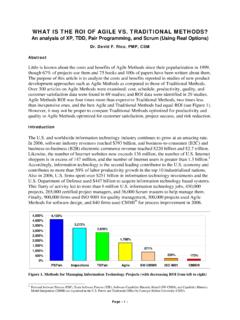Transcription of An Agile Approach to Release Management - SCM Patterns
1 An Agile Approach to Release Management1 of 56/4/08 6:35 PMAn Agile Approach to Release ManagementWritten by Steve Berczuk. Robert Cowham, Brad Appleton Monday, 26 May 2008 Teams practicing Agile Software Development valueworking software over other artifacts. A feature fromthe Release plan is not complete until you can demonstrate it to your customer, ideally in a shippablestate. Agile teams strive to have a working system("potentially shippable") ready at the end of eachiteration. Thus Release Management should be easy for an ideal Agile team, as Agile teams, in theory, areready to Release at regular intervals, and the releasemanagement aspect is the customer saying "ship it!." Agile teams work under the same constraints as othersoftware development teams, having to addressissues of maintenance and support, the need for external artifacts like documentation and training, andthe reality that not every customer can accept change at the rate that an Agile team can (in theory) deliver it.
2 To attain thegoal of a shippable product at the end of every iteration, an Agile team must manage the flow of change from a customer,and maintain high discipline and good engineering the paragraphs below we will discuss how Release Management works in an Agile project, and explain how even non-agileteams can benefit from applying aspects of an Agile Approach so that you can deliver value to your customers in a morepredictable Principles Agile Project Management Practices enable you to manage schedule risk in a project. In a sense, many are simply good practice:Plan to work in time boxed iterations of 2-4 weeksMaintain a backlog of feature requests in prioritized order, and revisit the priority at each iteration boundaryAt the start of an iteration select the highest value items from the backlog. Do detailed planning for these OftenVerify OftenDeliver and review against a plan.
3 These practices affect how you think about Release Management because Release Management is a planning activity and anyplanning activity has uncertainty which increases the further away you are from the present. The goal of having featurescomplete or not complete at the end of an iteration allows you to determine have a clear idea of what will be available to prioritization of the backlog allows you to compensate for problems by having the most important features developedfirst, so that you can still meet a Release date should that matter for market or regulatory reasons. The "always shippable"goal means that you can, if need be, accelerate your Release Agile Approach enables better Release planning by combining planning discipline, which helps you to focus on the highestvalue work, and engineering (including SCM) discipline, which helps you to identify and fix problems early, giving you morepredictability.
4 Agile practices make shipping a Release a decision that the product owners can make without worrying if theteam will meet a date far in the future. The role of the Agile team is to enable allow the product owner to make the decisionon short notice if need The IT Process Institute's report Change Configuration and Release Performance Study (full report costs $1,695 but the summary is available for free if you register) says that: Release trumps change - rigorous Release build, testing and rollback practices have broad impact on individualAn Agile Approach to Release Management2 of 56/4/08 6:35 PMperformance measures and overall performance. Change tracking and change oversight practices are necessary butnot sufficient to achieve performance improvement on their discipline matters - there are no change, configuration and Release silver bullets.
5 Building a process-focusedculture and monitoring and responding to process exceptions predicts top-levels of performance more than the manyof the industry recognized best practices in these is very much in line with an Agile Approach to software the focus of much of the literature on Agile methods is about single codeline development, ' Release Management ' oftenrefers not merely to managing a single Release , but to the overall discipline and methods of managing multiple releases at thesame time. There are all sorts of valid business reasons why you might need to support multiple releases. Maintainingmultiple codelines doesn't always mean you're not being Agile - particularly if each one of those is generating (or preventing the loss of) additional it may seem that having only a single stream of development is very restrictive, in practice it can work surprisinglywell.
6 That generally means having to deal with a change or a fix where you first have to determine which releases need it,and then how to inject it into (propagate to) possibly multiple Release streams. For these cases, Agile teams can use atraditional Release Line Approach , with an Agile Agile process also makes it easier to manage the disruptions to day-to-day development caused by bug fixes. The key tomanaging multiple Release streams in an Agile environment is to prioritize all the work for a team together. The product ownerneeds to decide how important a "bug fix" is compared to a feature. Agile planning techniques make the cost obvious. Allteams, not just Agile ones, work best in an environment where change is managed. When additional work is introducedmid-iteration, the performance of the team can suffer. The iteration Approach of Agile methods gives the product owner achoice when an issue presents itself: "do I fix this immediately, and forego feature work, or do I wait until the next iteration(2-4 weeks hence).
7 "Laura Wingerd discusses some of the basic "rules of the road" for "channeling the flow of change in software developmentcollaboration" in chapter 7 of her book, Practical Perforce. where she discusses the "flow of change rules" and the "tofuscale". The Tofu scale and change-flow rules/protocol are concerned with the relationships between codeline policies across the entire branching structure when it comes to making decisions about stability -vs- speed: One codeline's policy might make a certain tradeoff, but it is the presence of multiple codelines and how they work together, and how their policies definethe overall flow of change across codelines, that is key to Release Management across multiple releases+codelines. Thesechange-flow rules (which also relate to the Mainline pattern) advise us on exacvtly how and when to do this.
8 The change-flowrules are also well aligned with Lean principles ideas of minimizing the form of waste known as "inventory" or"work-in-progress" - functionality that has been developed but not yet have had experiences where applying an Agile Approach helped manage the flow of bug fixes. One team commented thattheir Agile method involved a 2 weekly Release cycle and they didn't need to rush bug fixes out - it had always been OK towait for the next Release . A key factor in the success of their development method was the trust that the rest of theorganization had in the process - work got done (and released), and if a feature was scheduled to go into a Release it almostinvariably Agile teams pride themselves on their ability to be responsive, being Agile does not mean being chaotic andundisciplined. Change has its cost, and Agile methods provide ways of making the cost of change explicit.
9 An Agile projectworks best when there is some sort of rhythm for Release cycles. Notice that we mentioned that a codeline is "potentiallyshippable." Whether or not to ship is a business decision. (Which is how it should be!) Even though the codeline is alwayssupposed to be "potentially shippable" all throughout an iteration, the decision to ship (or not) occurs at the end of aniteration. This is important, and emphasizes that the rumors that Agile processes are chaotic are not true. You need to planyour releases and iterations to align or you risk hurting the efficiency of the Release Management EnablersThey key enabling Patterns for an Agile project arePrivate BuildIntegration BuildRelease BuildContinuous Integration (with automated tests)An Agile Approach to Release Management3 of 56/4/08 6:35 PMRelease LineRelease-prep CodelineActive Development LineA Private Build enables all team members to test any changes they make with some degree of confidence that they will notbreak the codeline.
10 As part of the private build appropriate tests are run that give some degree of confidence that the codeworks. Because of the Private Build pattern team members can commit code often and thus have only small changes are committed an Integration Build serves as a gatekeeper for more exhaustive verification. The integrationbuild is run on a build server that may be using some sort of Continuous Integration tool such as Anthill, Cruise Control orTeam City. Since the exhaustive testing is run asynchronously from the development team, tests that you expect will passwill not delay commits. An Agile team often has a discipline that a failed Integration Build is an "all Hands" even, thusensuring that integration problems are addressed combination of small commits, and frequent integration means that the cost of change is small, enabling rapid Release Build and a Release -Line may seem like odd beasts to mention in an Agile context.








